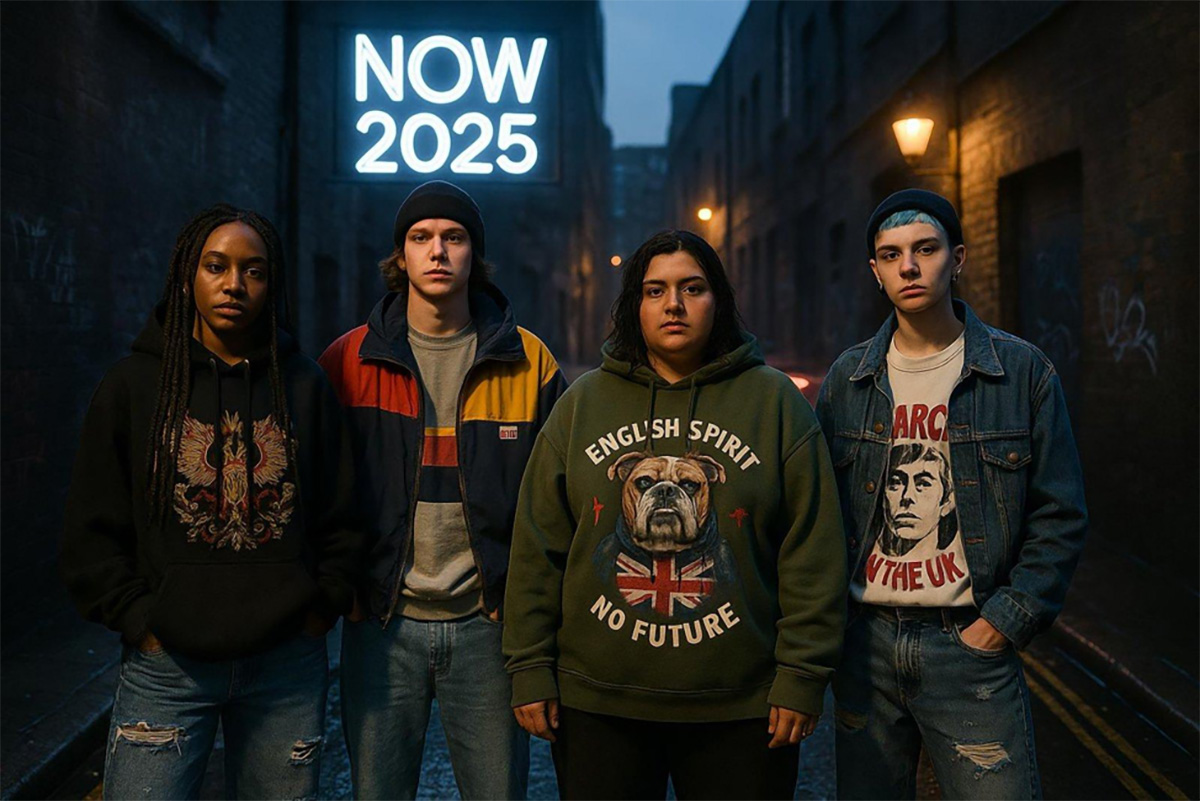The UK streetwear scene is changing fast, and a big driver is the sharp rise of personalised clothing. This looks set to stay. People want to stand out and show who they are. In a market filled with mass-made pieces, custom options help people create clothes that match their style, life, and values.
From custom T-shirts in London to made-to-order hoodies and accessories, personalisation lets people add their own story to what they wear. This shift changes what we buy, how we shop, and how brands work. Fashion is moving from fitting in to showing who you are. Demand for custom clothing in the UK is growing fast and is shaping where fashion goes next.
Personalised clothing is about more than looks. These pieces carry meaning, tell stories, and stand out in a crowd. This is especially clear in UK streetwear, where being real and different matters a lot. Below, we look at the main drivers, the methods people use, the items that are most popular, and how this shift affects shoppers and brands.
Why Personalised Clothing Is Reshaping UK Streetwear Culture
Personalised clothing is now a key part of UK streetwear. It’s no longer just about the newest drop. It’s about building a look that speaks for you. Streetwear has always been a space for personal and group expression, and custom gear fits that spirit.
Custom prints, embroidered marks, and made-to-measure fits help people move past off-the-rack limits. This freedom lets shoppers build a wardrobe that feels personal, which builds a stronger bond with what they wear. In streetwear, where being real and standing out matter, people now want to set trends and create one-off pieces.
What Drives the Rise of Personalised Clothing in UK Streetwear?
Many factors work together here: culture, tech, and changing shopper needs. Personalisation grows where these meet and support each other.
- Cultural shift: streetwear values identity, story, and community.
- Tech tools: easier design, better printing, and smart online platforms.
- Shoppers’ needs: uniqueness, meaning, fit, and better quality over quantity.

How Has Streetwear Evolved in the UK?
UK streetwear has moved from underground roots in skate and music scenes to global reach. What started with sportswear, workwear, and outerwear now shows a sharper, urban look with strong ideas behind it. In 2025, UK streetwear is a major force with a clear voice and bold ideas.
Music, street culture, and fashion from the UK drive this growth. Brands like Drama Call, Unknown London, and Corteiz show how community and clear messaging can lift a brand from local to global. This history of pushing for individuality helped set the stage for today’s custom boom.
Why Do UK Consumers Value Individuality in Fashion?
Many UK shoppers want pieces that feel unique and personal. In a market full of mass-made clothes, they want items that reflect their story. Reports show that over 60% of UK shoppers prefer clothing that matches their own style, especially Gen Z and millennials.
These groups value uniqueness, sustainability, and an emotional link to what they buy. Fashion is a way to show mood, beliefs, and personality. Custom clothing meets this goal, offering items that are stylish and meaningful-something mass-made products rarely match.
What Role Does Streetwear Play in Self-Expression?
Streetwear has long been a tool for self-expression, and personalisation makes that even stronger. Graphic hoodies, tees, and jackets share tastes, values, and ties without saying a word.
Today’s tech gives more ways to personalise: pick fabrics and colours, add custom prints and embroidery, and tune the fit. Clothing stops being just clothing; it becomes part of how someone presents themselves. In streetwear, where being real matters, custom pieces feel honest and direct.
What Personalisation Techniques Shape UK Streetwear?
The UK’s custom scene grows thanks to accessible methods that help people and brands turn basics into standout pieces.
Screen Printing, Embroidery, and Digital Customisation
Digital tools made personalisation easier, but classic methods still shine. Screen printing is great for bold colours and larger runs. Embroidery gives a textured, timeless look suited to logos, initials, and detailed marks on hoodies, caps, and tees.
Direct-to-Garment (DTG) printing changed small-batch custom work. It produces high-detail, full-colour prints and is ideal for short runs or single items. These tools help small brands and creators offer custom gear quickly and at fair prices.
- Screen printing: bold colours, cost-effective for larger quantities.
- Embroidery: textured, long-lasting, premium feel.
- DTG: detailed art, small runs, quick turnarounds.
On-Demand Manufacturing vs Traditional Production
Custom streetwear has pushed on-demand production forward. It sits in clear contrast to mass production, which often leads to overstock and waste.
| Approach | How It Works | Pros | Cons | Best For |
| Traditional | Make large batches based on forecasts | Lower unit cost at scale | Overstock, waste, limited variety | High-volume basics |
| On-demand | Make items after orders arrive | Less waste, more variety, lower risk | Longer lead times per item | Custom pieces, small runs |
For custom streetwear, on-demand fits well. Each piece is made for a specific person, so materials and time are used with purpose.
Innovative Materials and Tech-Driven Processes
New materials and tools are shaping the next wave of custom gear. More brands are trying organic fabrics, recycled fibres, and biodegradable textiles to meet rising demand for lower-impact fashion.
3D body scanning, AR fitting, and AI are set to change how we design and buy custom clothes. People will be able to try designs on virtually and get AI tips based on body shape, lifestyle, and taste. The process becomes more precise and more engaging.
What Kinds of Personalised Clothing Are Popular in UK Streetwear?
Many items work well for personalisation in UK streetwear. These pieces go beyond basics and become markers of identity.
Hoodies: UK Streetwear’s Custom Canvas
Hoodies are a favourite in UK streetwear and a perfect base for custom work. They are comfy, versatile, and easy to personalise with bold prints, fine embroidery, monograms, and text. Dream But Do Not Sleep shows how creative placements and repeat embroidery add depth and texture.
Custom hoodies mix comfort with a clear point of view. They suit laid-back looks while showing personal taste, ties, or mottos. Wide choices in colours, cuts, and fabrics make each hoodie feel truly personal.
T-Shirts Featuring Custom Graphics and Text
T-shirts are the most open and widely used custom item in streetwear. Their simple base highlights art, slogans, or personal messages. From a tee with a loved one’s face to a bold statement or a detailed illustration, options are endless. Digital printing and screen printing make it easy to get high-quality, unique tees.
The draw of custom tees is clear: they say who you are in a direct way. Sweet, bold, funny, or strange-each design serves its purpose and keeps T-shirts central to UK custom streetwear.

Customised Sweatshirts, Jackets, and Accessories
Beyond hoodies and tees, personalised streetwear also covers sweatshirts, jackets, and add-ons. Sweatshirts offer space for embroidery, prints, and collabs. Denim and track jackets make a strong statement with initials or custom art, adding a touch of luxury to daily wear.
Accessories matter too. Think caps stitched with hot pink thread or custom trainers that match your look. Small touches can pull an outfit together and add more identity. With so many ways to customise, people can build full outfits that reflect their style.
How Does Personalised Clothing Benefit UK Streetwear Enthusiasts?
For streetwear fans in the UK, custom clothing offers clear wins tied to identity, comfort, and smarter buying.
Uniqueness and Self-Expression
Personalised clothing gives a rare level of uniqueness and self-expression. In a trend-led market, making one-off pieces is very appealing. Through custom embroidery, prints, and made-for-you designs, people build outfits that match their taste and story.
Custom pieces help wardrobes look different from one another. It’s not only about standing out; it helps people feel confident about who they are and what they want to say.
Better Fit and Comfort
Another big benefit is fit and comfort. Sizing in mass-made clothes often varies. Custom garments can be made to your measurements, giving a fit that feels right.
This brings more comfort and often boosts confidence. For anyone who struggles with off-the-rack sizing, made-to-fit options can change the game. Good fit tends to look better and feel better-ideal for active streetwear use.
Supporting Emerging Designers and Independent Labels
The rise of custom clothing helps small UK businesses and independent designers. As more people move away from fast fashion and choose meaningful buys, niche brands offering custom designs are growing. These labels often focus more on care and skill than big chains.
Buying from these makers supports the local fashion scene and sparks new ideas. Shoppers get unique, thoughtful pieces, while small brands grow by meeting the demand for personal style.
Emotional Value and Lasting Appeal
Custom gear often carries deeper meaning. A jacket with initials, a tee for a special moment, or a hoodie with a personal graphic can hold memories that mass-made items rarely match.
This bond makes people less likely to throw items away. They wear them more, care for them, and keep them longer. That cuts waste and supports a slower, more mindful way to buy and wear clothes.
What Is the Impact of Social Media and Online Platforms?
Social platforms sped up the custom clothing wave in UK streetwear. They shape trends, connect brands and fans, and make custom design feel normal.
Influence of TikTok, Instagram, and Online Communities
TikTok and Instagram work like engines for personal style. Influencers and fans show off custom hoodies, tees, and accessories every day. This constant stream of looks pushes more people to try personalisation.
Streetwear forums and groups add to this. People share designs, find new independent makers, and talk about custom work. A standout design can go viral in a day, sparking fresh demand and ideas across the UK scene.
How Online Customisation Tools Are Changing the Game
Modern online tools make custom clothing open to more people. Many shops now let you design online-pick fabrics, colours, styles, and add prints or embroidery with a simple interface. This gives shoppers control that standard retail never offered.
Behind the scenes, better printing and production keep costs fair and timelines short. Virtual fitting and AR previews are growing too, so customers can see their ideas before they buy. People are no longer just buyers; they are co-creators.
How Is Sustainability Addressed Through Personalised Streetwear?
Sustainability matters to shoppers and brands, and custom streetwear offers practical ways to lower impact.
Reducing Waste with On-Demand Production
On-demand production cuts waste. Fast fashion often overproduces, which leads to unsold stock and landfill. Custom items are usually made after an order comes in, which sharply reduces leftover inventory.
Because each piece is made for someone in particular, fewer resources are wasted from start to finish. It supports a slower, smarter buying cycle and a leaner system.
Use of Eco-Friendly Materials and Ethical Sourcing
Many custom streetwear brands now use organic fabrics, recycled fibres, and biodegradable textiles. Shoppers look for these choices, and they set brands apart.
Ethical sourcing matters too. Clear supply chains, fair labour, and lower environmental impact build trust with informed buyers. Many custom makers share details about their methods and eco-printing to back up their claims.
Longevity Over Fast Fashion Cycles
Custom streetwear tends to last longer. When someone helps design a piece, they care for it more and wear it more often.
Quality also plays a role. Well-made items, built from hard-wearing materials, handle daily use better. Buying fewer, better pieces helps break the throwaway habit and supports a more mindful way to dress.
What to Look For When Choosing a Personalised Streetwear Brand
With more options on the market, picking the right brand matters. Look for signs of quality, openness, and a smooth customer journey.
Quality, Customisation Options, and Customer Experience
Quality should come first. Pick brands that use good materials and solid build methods, so pieces last and feel good to wear. Fabric choice affects comfort and lifespan, so check what they use.
Range matters too. A strong set of options-screen printing, embroidery, DTG, different garment types, and design choices-helps you create something truly your own. Also weigh the customer journey. Clear online tools, good communication, and helpful support make design and ordering simple and pleasant.
Transparency in Sourcing and Production
Many shoppers expect open sourcing and production. A good brand shares where materials come from and how items are made, including labour standards and environmental impact. Brands that show real care in these areas build trust.
This openness should include printing and finishing methods. Details on eco-inks and lower-impact processes help customers make informed choices.
Community Engagement and Brand Reputation
Active community work and a solid reputation are strong signals. Brands that listen on social media, invite feedback, and build two-way ties often deliver better experiences.
Read reviews and testimonials to learn how others felt about fit, finish, and service. Look for a brand that matches your values, offers wide custom options, and stands by its work for a lasting relationship.
What Future Trends Will Shape Personalised Clothing in UK Streetwear?
Personalised streetwear in the UK is set to become smarter, more connected, and greener.
Predictive AI and Deeper Personalisation
AI will guide design choices based on your past picks, social activity, body data, and taste. It will suggest graphics, colours, fabrics, and cuts that fit you well. People will preview custom fits on a screen and get clear guidance even if they’re not designers.
Expansion from Individual Identity to Group and Community Customisation
Custom gear won’t stop at the individual. Teams, collectives, and local groups are already ordering custom pieces for identity and pride. Expect more streetwear drops for local music scenes, gaming groups, and neighbourhood projects that show a shared voice.
Bringing in Sustainable and Circular Fashion Principles
Sustainability will go deeper. More custom items will use organic, recycled, and biodegradable materials as standard. Circular ideas will grow too: repair services, remake options, and programs that help people refresh or rework old pieces. The UK’s strong focus on low-impact fashion will keep pushing this forward.




